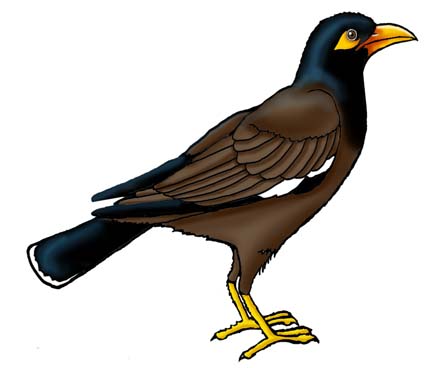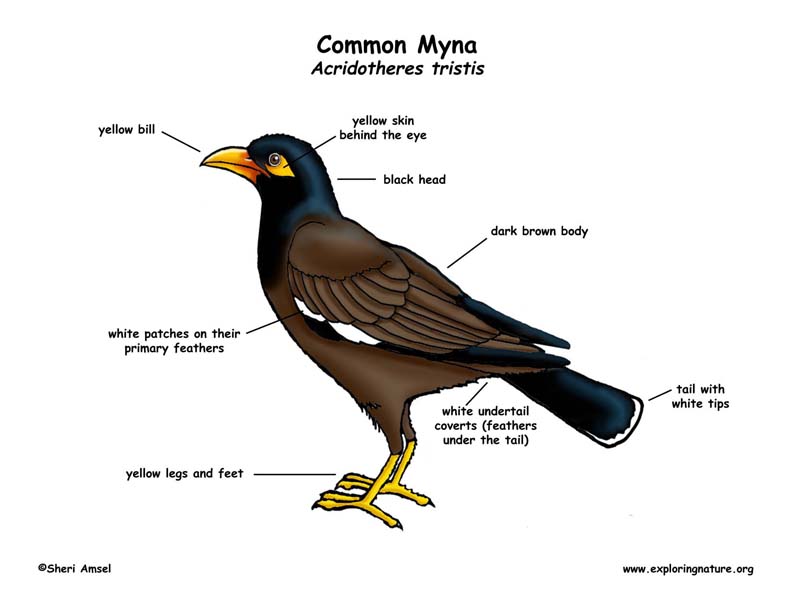

They are found in southern Asia and India, but have been introduced to other tropical regions (like Hawaii) and to Australia for agricultural pest control.
They live in warmer climates in open areas along the edges of forests and urban areas and around farms. They are also found in open woodlands and roost in trees.
They can reach 10-inches long and are dark brown with a black head. Males and females look alike (no sexual dimorphism) though males may be slightly larger. They have a distinctive yellow bill, yellow legs and a yellow patch of skin behind the eye. They have a medium-length tail with white tips. They also have white patches on their primary feathers and on their undertail coverts (feathers under the tail).
They are territorial and mated pairs will aggressively battle other pairs for nesting sites. Newly independent fledglings often form small flocks. After the breeding season is over, large flocks gather and will roost together for safety against predators. They are very vocal and will scream high-pitched calls in warning. Mynas are known for their tame behavior around humans, so are often kept as pets. They have been known to imitate human speech.
They are omnivores, eating mostly fruit and grain but also insects, spiders, nectar, eggs, fish, worms, crabs, lizards, small snakes and mammals. They will even scavenge through garbage. They search for food on the ground or while wading in shallow water. While hunting for food on the ground, they are often hopping sideways.
Nestlings are eaten by house cats, mongoose and crows. Adults are sometimes eaten by humans or captured for the pet trade.
Males attract a mate with a courtship display that includes a dance of bobbing, bowing and fluffing feathers. Once they are mated, mynas are monogamous and they will defend their nesting territory together. They build their nest together and spend time preening each other. Females then lay up to 5 blue eggs and both parents take turns warming them (incubate). They take about 2-3 weeks to hatch. Chick stay in the nest for 3-4 weeks and the parents will continue to feed them and protect them until they are independent and can fly by about 6 weeks old.
They may live less than 5 years in the wild.
Kingdom: Animalia
Phylum: Chordata
Class: Aves
Order: Passeriformes
Family: Sturnidae
Genus: Acridotheres
Species: A. tristis
When you research information you must cite the reference. Citing for websites is different from citing from books, magazines and periodicals. The style of citing shown here is from the MLA Style Citations (Modern Language Association).
When citing a WEBSITE the general format is as follows.
Author Last Name, First Name(s). "Title: Subtitle of Part of Web Page, if appropriate." Title: Subtitle: Section of Page if appropriate. Sponsoring/Publishing Agency, If Given. Additional significant descriptive information. Date of Electronic Publication or other Date, such as Last Updated. Day Month Year of access < URL >.
Amsel, Sheri. "Myna (Common)" Exploring Nature Educational Resource ©2005-2024. December 14, 2024
< http://www.exploringnature.org/db/view/Myna-Common >

